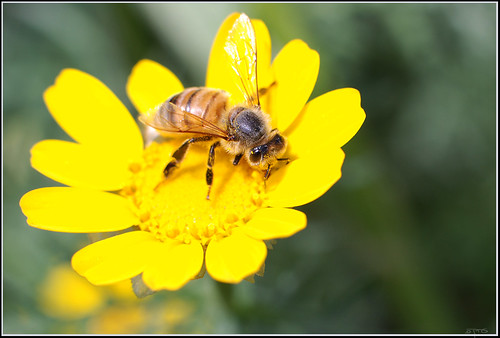Bees and Mobile Phones: A Wire Story
Digital Trends and Yahoo News must have no editorial staff whatsoever. How else could this wire story claiming a connection between cell phones and colony collapse disorder of honeybee hives by Andrew Couts have been published? Its prose is surpassed in badness only by its reporting. Given that the source is an eight-page, nontechnical research study, that’s saying something.1
I feel bad that Couts’s story is already in the ether, but I can’t do anything about that. What I can do is write a competing wire story. If you share it widely with your friends, perhaps his bad reporting can be pushed into irrelevance.2
Teenagers and Bees Have a Lot in Common, Study Finds
What do teenage girls and bees have in common? Both get louder and screechier the longer they use a cell phone!
 In a study published this month, researcher Daniel Favre of the Swiss Federal Institute of Technology found that if you let bees use a mobile phone for more than 30 minutes, the sound the hive makes gets louder and higher pitched.
In a study published this month, researcher Daniel Favre of the Swiss Federal Institute of Technology found that if you let bees use a mobile phone for more than 30 minutes, the sound the hive makes gets louder and higher pitched.
To conduct the study, Favre tested five different bee colonies. He recorded the sounds a colony would make when he placed a mobile phone in the hive. He tested the phones when they were off, when they were in standby, and when they were transmitting, and he compared all three recordings to the sound a colony makes when when there are no cell phones in the hive at all. Sounds were compared using spectrograms, or visual depictions of sound waves.
The noise of the bee colonies only changed when the mobile phones were transmitting. The louder, higher-pitched sound the bees made is known among bee researchers as the worker piping signal. It’s the sound a hive makes when it’s about to swarm, or fly off and establish another colony. The worker piping signal is rare enough that Favre attributed the change to the phones.
“Active mobile phone handsets in beehives noticeably induce the rate of worker piping,” Favre said.
Crucially, however, even after leaving a transmitting mobile phone in the hive for 20 hours, no hive actually swarmed, and all hives eventually returned to normal.
 Favre hypothesized, “It might be possible that a more prolonged exposure of the honeybees to the actively communicating mobile phone handsets is required for the complete induction of the swarming process.”
Favre hypothesized, “It might be possible that a more prolonged exposure of the honeybees to the actively communicating mobile phone handsets is required for the complete induction of the swarming process.”
The study’s findings were conclusive: Mobile phones inside beehives really do alter bees’ behavior. But why the bees were excited by the phones is still unknown.
What is certain is that if a bee colony does get to use a mobile phone for more than 20 hours, its cell phone bill would be astronomical—and you can bet those bees would be grounded for at least a month!
| Carrier | Minutes | Base Price | Overage Price | 20 Hour Cost (not including taxes) |
|---|---|---|---|---|
| Sprint | 200 | $29.99 | $0.45/m | $515.99 |
| AT&T, Sprint, Verizon |
450 | $39.99 | $0.45/m | $377.49 |
| AT&T, Sprint, Verizon |
900 | $59.99 | $0.40/m | $179.99 |
| Sprint | Unlimited | $99.99 | – | $99.99 |
| AT&T, Verizon |
Unlimited | $69.99 | – | $69.99 |
Science, whether good or bad, need not be reported badly, too—especially science as simple as this.
1 It seems obvious that Couts wanted to maximize the number of hits on his story (his pay is probably tied to hit count), so he made shit up in order to have as sensational a story as possible—fit to fool my Aunt, anyway. I’m sure it helped that the study sat at the intersection of one of the more ominous environmental stories of the past few years, colony collapse disorder (CCD), or the strange worldwide dying off of honeybee colonies, and one of the favorite themes of conspiracy theories, the unforeseen consequences of technological change. Never mind that it was reported last year that CCD appears to be caused by a combination of a viral and fungal infection (though I notice here that that study’s findings are in question). Of course, a more measured story like that wouldn’t freak out my Aunt like Couts’s story did—which is probably why he didn’t write it.
2 Yeah, yeah, yeah. The lede is as obnoxious as Couts’s. But my story represents the research accurately, anyway.



Comments
May 18, 2011
KL / May 18, 08:49 PM
You lost me at “teenage girls.”
Commenting is closed for this article.